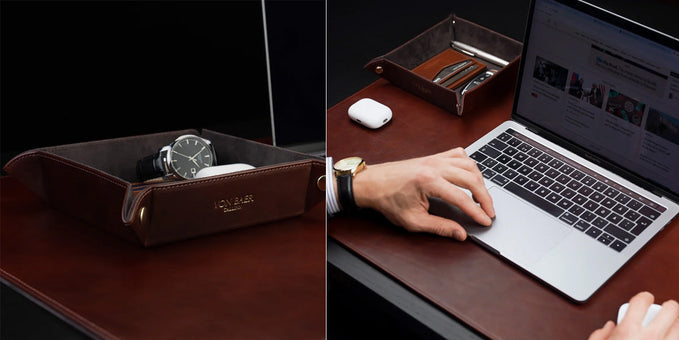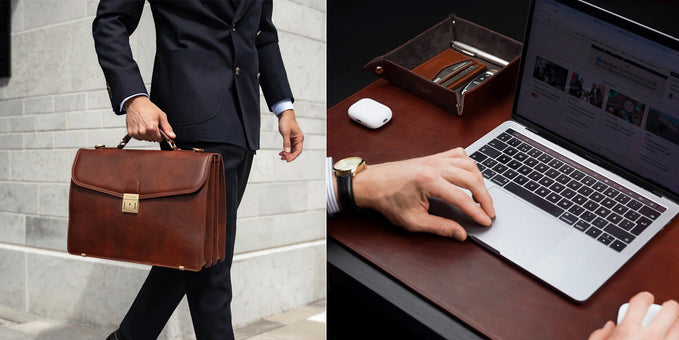How To Fix Scuffed Leather

No one likes to see scuffs in leather.
Follow our in-depth guide to help minimize the damage that scuffs will cause on leather shoes, bags, and accessories.
Repairing Light Surface Scuffs
For light surface scuffs on leather, there are several quick fixes you can try:
- Using a Hair Dryer: Gently blow warm air over the scuffed area while massaging the leather with your fingers. The heat helps the leather's natural oils redistribute and diminish the appearance of the scuff.
- White Vinegar: Dab a small amount of white vinegar onto a soft cloth and gently rub the scuffed area. This can help remove superficial scuff marks and restore the leather's shine.
- Petroleum Jelly: Apply a small amount of petroleum jelly to the scuffed area and rub it in using a clean cloth. Let it sit for a few hours or overnight, then wipe away any excess. The petroleum jelly helps moisturize and soften the leather, reducing the visibility of the scuff.
- Leather Cream: Finish the item with a leather cream, to moisturize and protect it. We recommend this Premium Leather Cream.
Repairing Serious Surface Scuffs
For more significant surface scuffs, consider these steps:
-
Leather Glue: Apply a small amount of leather glue to the scuffed area and press it down gently. Wipe away any excess glue with a damp cloth and let it dry completely.
If you're looking for a reliable well-tested leather glue, feel free to purchase one here here.
-
Recoloring Marker: Use a recoloring marker that is similar to your leather's color to cover up the scuff. Apply the marker in light, even strokes until the scuffed area blends in with the rest of the leather. Let it dry according to the marker's instructions.
Discover and buy your perfect shade from our well-tested range of brand permanent marker pens here here.
- Leather Cream: Finish the item with a leather cream, to moisturize and protect it. We recommend this Premium Leather Cream.
Fixing Deeper Scratches and Scuffs:
-
Leather Repair Kit: Purchase a leather repair kit that includes a sealer, filler, and binder. Clean the affected area and apply the binder, allowing it to dry completely.
Discover, combine, and purchase your leather repair kit here here.
- Filler Application: Use a palette knife or spatula to apply the filler to the scuffed area, smoothing it evenly. Let it dry and repeat if necessary, until the surface is level.
- Sealing the Repair: Apply the sealer from the repair kit over the filled area, following the instructions provided. This step helps protect and blend the repair with the surrounding leather.
- Leather Cream: Finish the item with a leather cream, to moisturize and protect it. We recommend this Premium Leather Cream.
Remember, it's always a good idea to test any cleaning or repair method on a small, inconspicuous area of the leather before proceeding with the entire scuffed area. This ensures that the method won't cause further damage or discoloration.

Trying Quick Fixes
Method 1: Using a Hair Dryer
- Adjust the hair dryer to a warm setting.
- Carefully heat the damaged, scuffed surface of the leather using the hair dryer.
- Softly massage the warmed leather with your hands to decrease the visibility of the scuff.
- Ensure that the air stream from the hair dryer is not too hot to avoid damaging the leather.
Method 2: White Vinegar
- Moisten a cotton ball or swab with white vinegar (distilled).
- Dab the damaged area with the vinegar-soaked cotton ball to slightly swell the leather.
- Allow the area to dry.
- Polish the area using a colorless shoe polish for optimal results.
- This method works well for scuffed shoes or handbags.
Method 3: Petroleum Jelly
- Apply a small amount of colorless and fragrance-free petroleum jelly to a clean cloth.
- Rub the petroleum jelly onto the affected area using circular motions.
- Leave it on for approximately 10 minutes.
- Remove any excess petroleum jelly with a clean cloth.
- Be cautious to avoid potential damage to the leather.
Method 4: Recoloring Balm
- Purchase a recoloring balm from a nearby fabric or home improvement store, or online.
- If an application sponge is not available, apply the balm directly to a piece of cloth.
- Gently rub the recoloring balm into the leather using circular motions.
- Ensure thorough coverage and allow the balm to penetrate the leather effectively.
- Follow the instructions provided for the recommended setting time.
- Use another piece of cloth to remove any excess product.
Using Leather Glue to Treat Minor Scuffs
Step-by-step instructions:
- Start by cleaning the scuffed area using a leather cleaner. Follow the instructions on the cleaner's label to ensure proper usage.
- This step will eliminate dirt, oils, and other substances that can interfere with the repair process and prevent discoloration.
- Cleaning the area will also prepare the leather's surface for the subsequent repair and recoloring steps.
- To lift the scuffed fibers, use a tool with a sharp edge like a spatula. Gently run the tool opposite to the scuff, aiming to lift the damaged fibers away. This will create access to the area beneath the fibers, where you'll apply the leather glue.
- Place a tiny amount of the leather glue on the edge of the tool or spatula. Apply it to the underside of the scuffed fibers by pulling the tool opposite to the grain. Take care to apply the glue thoroughly and evenly, using short and even strokes.
- To remove excess glue and air bubbles, rub the fixed surface. After applying the glue on the grain, start rubbing the tool to the scuff. This action will flatten the area and eliminate any air bubbles. By rubbing with the grain, you'll also return the scuffed fibers to their original place, aligning them with the surrounding leather surface. You can use your finger to remove any excess glue.
- If needed, recolor the damaged area using a leather marker that matches your leather. Apply thin coats of the recoloring marker, feathering the outer parts of the recolored area, so it can blend seamlessly with the surrounding leather. Keep in mind that light scuffs may not require any recoloring, so examine the area after you apply the leather glue.
Related articles:
- Repair cat scratches on leather
- Remove water stains from leather
- Clean leather wallet & remove stains/smells
- Remove ink from leather
- Get smell out of leather
- Remove stains from leather shoes
- Clean suede leather bag
- How to reform a leather bag
- How to maintain leather bags
- Repair cracked leather

Repairing Scratches and Deep Scuffs
- Begin by cleaning the area and trimming loose fibers.
- Utilize a leather cleaner to get rid of the oil and dirt from the surface before proceeding with the repair.
- Using a pair of small scissors, carefully trim any extended fibers that may be hanging from the affected area.
- Leave any shorter loose fibers that you can't access using the scissors, as they will not interfere with the repair process.
- Apply leather binder using a sponge.
- Take a clean, dry sponge and apply some leather binder to it.
- Coat the affected area with the binder, following the instructions on the product's label regarding drying time.
- Allow each coat to dry before applying the next one.
- For optimal results, apply eight to ten coats of binder.
- Use fine-grain sandpaper to sand the area.
- Take a 1200 grit sandpaper and start sanding the area where the binder has been applied.
- Use circular motions to create a smooth surface across the repaired area.
- After sanding, blow away any remnants or use a microfiber towel to wipe the surface.
- For repairing deep scratches, it is recommended to apply a generous amount of filler.
- Use a palette knife or putty knife to evenly spread a layer of filler over the affected area.
- Allow the filler to dry for approximately 20 to 25 minutes.
- If necessary, apply additional coats of filler until the gouges or scratches are leveled with the surface.
- Sand the surface again and wipe using an alcohol-based cleaner.
- Once the filler has dried, use sandpaper (1200 grit) to sand the surface again.
- Use gentle motions to ensure a smooth finish.
- After sanding, wipe the repaired area with an alcohol-based cleaner to remove any residue.
- Give it a few minutes to dry.
- Recolor and seal the fixed surface.
- If the container of the leather colorant does not come with an applicator, you can use a dry, clean sponge.
- Apply a layer of colorant to the repaired area, following the instructions on the product for drying time.
- After successfully achieving the desired color and seamlessly blending the repaired area, it is advisable to apply 3-4 thin layers of the leather sealer.
- This will provide a resilient and flexible finish, ensuring long-lasting protection for the repaired section of the leather item.
Related articles:
- Wet leather
- How to clean leather bag
- How to restore faded leather bag
- How to stretch leather
- How to shrink leather
- How to soften leather
- How to wash leather
- How to fix faux leather peeling
- Bleach On Leather
- Leather
- Where does leather come from
- Leather grades
- How is leather made
- Italian leather
- How to tell if leather is real
Preventive measures
To make sure that your leather remains scuff-free, you should follow these tips.
- Use protective creams/sprays: There are creams and sprays that add a layer to your leather items to protect them from scratches and scuffs. We recommend this Premium Leather Cream.
- Minimize sunlight exposure: Try to minimize sunlight exposure on your leather items as it can cause fading and drying of the leather.
Regular cleaning and conditioning: Make sure to follow a consistent cleaning and conditioning routine using the recommended leather cleaners to ensure longevity for your leather items.
Conclusion
We hope you enjoyed our article on how to fix scuffed leather.
If you have any questions or comments, contact us at info@vonbaer.com, or leave them in the comments.
Want to read more? Check out our Leather pages.
Related articles:
- How To Clean Mold off Leather
- How To Clean Faux Leather
- How To Repair Leather
- Leather Burning
- Best Leather Cleaners & Conditioners
- How To Get Sharpie off Leather
- How To Clean Suede
- DIY Leather Conditioner
- Wet Molding Leather
- Best Leather Oil
- How To Clean White Leather
- How To Get Oil Out of Leather
- Clean Leather Car Seats

Author: Albert Varkki
Albert Varkki is the co-founder of Von Baer. He understands leather products as a consumer, supplier, and a manufacturer, helping you with the inside knowledge you need, to choose the perfect leather product for you.
We strive for the highest editorial standards, and to only publish accurate information on our website.
Leave a Comment
Your email address will not be published.






